On Friday March 9th the U.S. Bureau of Labor Statistics (BLS) released their monthly employment survey results for the month of February.
According to the BLS the Seasonally Adjusted U-3 Unemployment Rate for February is unchanged for the 5th month in a row. That’s right from October through February the Seasonally Adjusted Unemployment rate has been 4.1%.
This is a very low level and we really don’t expect it to get too much lower.
Key February Employment and Unemployment Numbers
- Adjusted U-3 Unemployment- 4.1% unchanged since October.
- Unadjusted U-3 Unemployment- 4.4% down from 4.5% January.
- Unadjusted U-6 Unemployment- 8.6% down from 8.9% in January.
- Employment 146.696 million up from 145.473 million in January but down from 148.346 million in December and 148.526 million in November.
- Gallup has discontinued publishing U-6 & U-3 numbers.
See Current Unemployment Chart for more info.
Employment by Sector
The employment “bubble chart” gives us a good representation of how each sector of the economy is doing (employment wise). As we can see from the chart below the only sector to the left of the zero line is Information meaning that all other sectors gained employees in February except information which lost -12,000 employees on a “Seasonally Adjusted” basis.
The biggest gainer was construction (bubble furthest to the right) which added 61,000 jobs, followed by Retail Trade which gained 50,300 jobs and Professional and Business Services which gained 50,000 jobs even manufacturing gained 31,000 jobs. (See the table below the chart for average weekly earnings and other details.)
How to read this chart:
Bubbles location on the chart tell us two things:
- Change in Employment Levels over the most recent month.
- Average Weekly earnings.
- The further to the right the bubble the larger the increase in the number of jobs.
- The higher up on the chart the larger the average salary.
Bubble Size tells us:
- Total Employment for the sector.
- Larger bubbles mean more people are employed in that sector.
Employment and Average Weekly Earnings by Industry for All Employees
February 2018, Seasonally Adjusted
| Industry | Monthly Increase | Average Weekly Earnings | Employment Level |
| Total Private Employment | 287,000 | $922.88 | 125,819,000 |
| Mining and Logging | 8,000 | $1,485.78 | 713,000 |
| Construction | 61,000 | $1,158.17 | 7,173,000 |
| Manufacturing | 31,000 | $1,100.03 | 12,614,000 |
| Wholesale trade | 5,800 | $1,185.12 | 5,956,200 |
| Retail trade | 50,300 | $572.55 | 15,926,200 |
| Transportation and Warehousing | 15,400 | $940.60 | 5,263,400 |
| Utilities | 1,200 | $1,658.82 | 553,400 |
| Information | -12,000 | $1,418.40 | 2,748,000 |
| Financial Activities | 28,000 | $1,290.81 | 8,547,000 |
| Professional and Business Services | 50,000 | $1,161.30 | 20,760,000 |
| Education and Health Services | 23,000 | $882.75 | 23,466,000 |
| Leisure and Hospitality | 16,000 | $410.81 | 16,262,000 |
| Other Services | 10,000 | $768.73 | 5,837,000 |
U-6 Unemployment
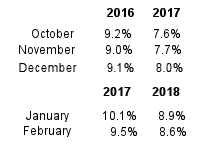
From the table at the left we can also see that U-6 unemployment went from 9.2% in October 2016 to 7.6% in 2017.
Similarly it fell from 9.0% in November 2016 to 7.7% in 2017 and from 9.1% in December 2016 to 8.0% in 2017.
See Unadjusted U-6 unemployment for more info.
Employment
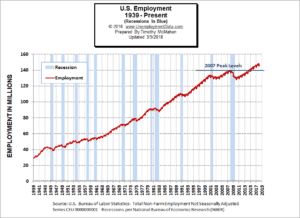

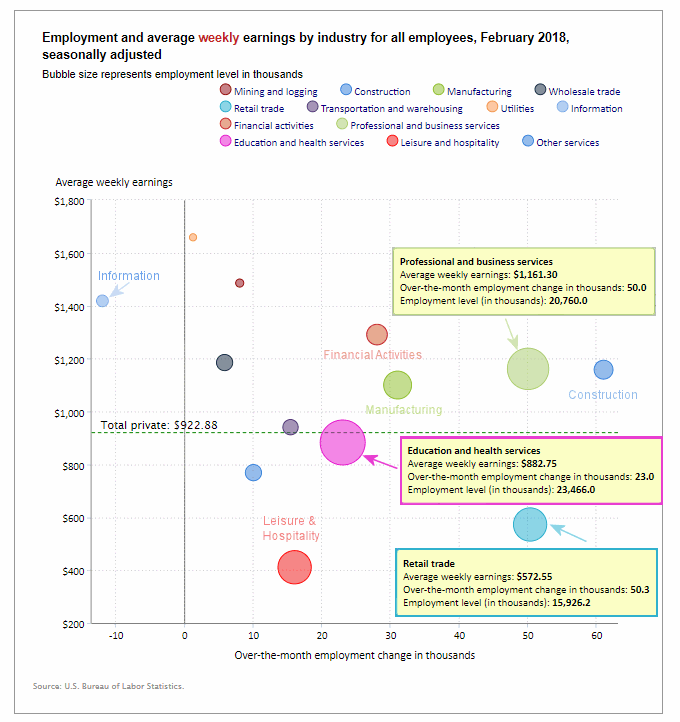
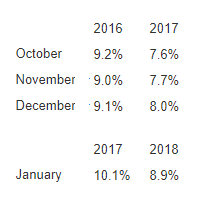 Over the same period, Unadjusted U-6 unemployment which is a broader measure of Unemployment including discouraged workers, climbed steadily.
Over the same period, Unadjusted U-6 unemployment which is a broader measure of Unemployment including discouraged workers, climbed steadily.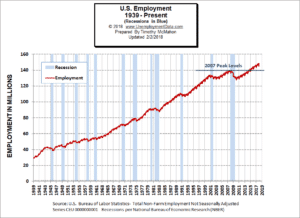 Over the last month, the actual number of people working (not seasonally adjusted) has decreased by
Over the last month, the actual number of people working (not seasonally adjusted) has decreased by